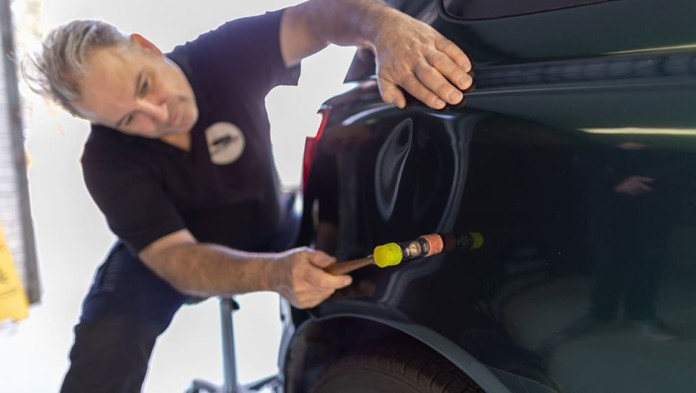PDR is an abbreviation for Paintless Dent Repair – which means the management of dents and damages caused to car bodywork without traditional repairing methods.
This method covers a wide range of damages that can be repaired without varnishing and painting the bodywork.
The PDR repair technique can be applied to sheet metal and aluminum parts of car and engine bodies. The most common use of the PDR technique is in cases of damage to the sheet metal caused by hail and ice, damage caused by door-to-door blows, and larger and smaller depressions caused by other influences. The success of PDR repair depends on the flexibility of the painted surface, the size of the damage, and the metal structure of the body.
How is the PDR repair done?
The repair of the damaged car body is done after dismantling the lining on the inside/bottom of the element. Depending on the position of the damage, the most common method is repairing the car body with a lever system, if the damage is accessible from the inside.
If it’s not possible to approach the indentation/damage from the inside, a special system for extracting the indentation from the outside is applied, using glue and appropriate tools. After the repair, the linings are returned to their place and the car body is once again thoroughly inspected and cleaned before it is delivered to the client.
Auto body shop Prince Albert is an SGI accredited Elite auto body repair shop and a market leader in the collision repair industry especially experienced in paintless dent repairs including hail dents and cosmetic dents. Rest assured your car is in good hands with our experienced dent repair specialists. Apart from PDR, we take pride in a wide range of auto body repair services including collision repair services, auto glass services, and SGI accident claims. With the highest level of care for our customers and their vehicles, we are the market leader in the collision repair industry through training, cutting-edge equipment, repair material technology, and best repair practices.
Standard PDR procedure
The remediation process includes 4 steps:
1. Damage assessment
2. Gaining entry to the dent
3. Massaging the sheet metal to its original position
4. Pressure and straightening
Damage assessment
The first step of any PDR repair procedure is damage assessment. Where is the recess? What is the recess? How do we get to the recess? After assessing the damage and determining whether it can be effectively removed with PDR, we prepare the area around the recess for repair.
Gaining entry to the dent
In most cases, PDR requires access from the rear of the recess, which means careful removal of body panels, taillights, or, in some cases, interior panels. To perform PDR, you need a path to the recess. Once we have access to the recess, it is time to repair the PDR. This is where the precision and expertise of our trained technicians take place.
Massaging the sheet metal to its original position
To have a better look at the recess and decide on the best possible method to repair it, the PDR technician uses a special light board in his work.
The board perfectly shows the shadow of the recess, telling the technicians where exactly to place the tools at the back of the recess to massage the car body and return it to its original state.
Then special tools are used to carefully massage the sheet metal to return it to its original position.
The PDR process can be completed on the same day, depending on the severity of the indentation, the results are amazing and the process itself is non-invasive and fast.
How much damage can PDR actually eliminate?
The PDR method can remove various types of dents, dirt, and creases and is a specialized technique used to quickly and economically return the vehicle to its factory condition.
In addition, if there is no damage to the color, the dent, thread or crease can probably be repaired using the PDR technique. What’s more, PDR is a great solution to help restore your vehicle to its original condition on potholes of all sizes, including greater damage from various weather conditions and accident damages.
What is the difference between the traditional sheet metal straightening and the PDR method?
In the traditional method, putty and paint are used to correct dents. When selling a car, the price of the vehicle falls because it was hit and painted. Unlike the traditional method with PDR, the concave body returns to its original position so that nothing is noticed.




